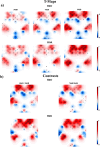Sound intensity-dependent cortical activation: implications of the electrical and vascular activity on auditory intensity
- PMID: 40496979
- PMCID: PMC12149058
- DOI: 10.1007/s11571-025-10281-7
Sound intensity-dependent cortical activation: implications of the electrical and vascular activity on auditory intensity
Abstract
Recent studies combining electroencephalography (EEG) and functional near-infrared spectroscopy (fNIRS) have shown promising results linking neural and vascular responses. This study analyzes the topographical effect of auditory stimulus intensity on cortical activation and explores neurovascular coupling between fNIRS hemodynamic signals and auditory-evoked potentials (AEPs), extracted from EEG. Forty healthy volunteers (13 males, 27 females; mean age = 22.27 ± 3.96 years) listened to complex tones of varying intensities (50-, 70-, and 90-dB SPL) across seven frequencies (range of 400-2750 Hz) in blocks of five, while EEG and fNIRS were recorded. PERMANOVA analysis revealed that increasing intensity modulated hemodynamic activity, leading to amplitude changes and enhanced recruitment of auditory and prefrontal cortices. To isolate stimulus-specific activity, Spearman correlations were computed on residuals-components of AEPs and fNIRS responses with individual trends removed. The N1 amplitude increase was correlated with higher superior temporal gyrus (STG) and superior frontal gyrus (SFG) activity, and reduced activity in inferior frontal gyrus (IFG) for the oxygenated hemoglobin (HbO), while the deoxygenated hemoglobin (HbR) was associated with increased activity in one channel near the Supramarginal Gyrus (SMG). P2 amplitude increase was associated with higher activation in SFG and IFG for HbO, while for HbR with the activity in SMG, angular gyrus (AnG), SFG, and IFG. Additionally, internal correlations between fNIRS channels revealed strong associations within auditory and frontal regions. These findings provide insights into existing models of neurovascular coupling by showing how stimulus properties, such as intensity, modulate the relationship between neural activity and vascular responses.
Supplementary information: The online version contains supplementary material available at 10.1007/s11571-025-10281-7.
Keywords: AEPs; Auditory intensity; FNIRS; Neurovascular coupling.
© The Author(s) 2025.
Conflict of interest statement
Competing interestsThe authors declare no competing interests.
Figures







Similar articles
-
Neurovascular coupling during auditory stimulation: event-related potentials and fNIRS hemodynamic.Brain Struct Funct. 2023 Nov;228(8):1943-1961. doi: 10.1007/s00429-023-02698-9. Epub 2023 Sep 2. Brain Struct Funct. 2023. PMID: 37658858 Free PMC article.
-
EEG signatures of auditory activity correlate with simultaneously recorded fMRI responses in humans.Neuroimage. 2010 Jan 1;49(1):849-64. doi: 10.1016/j.neuroimage.2009.06.080. Epub 2009 Jul 8. Neuroimage. 2010. PMID: 19591945
-
Enhancing fNIRS Analysis Using EEG Rhythmic Signatures: An EEG-Informed fNIRS Analysis Study.IEEE Trans Biomed Eng. 2020 Oct;67(10):2789-2797. doi: 10.1109/TBME.2020.2971679. Epub 2020 Feb 6. IEEE Trans Biomed Eng. 2020. PMID: 32031925
-
Speech-evoked cortical activities and speech recognition in adult cochlear implant listeners: a review of functional near-infrared spectroscopy studies.Exp Brain Res. 2024 Nov;242(11):2509-2530. doi: 10.1007/s00221-024-06921-9. Epub 2024 Sep 21. Exp Brain Res. 2024. PMID: 39305309 Free PMC article. Review.
-
Stimulus-dependent activations and attention-related modulations in the auditory cortex: a meta-analysis of fMRI studies.Hear Res. 2014 Jan;307:29-41. doi: 10.1016/j.heares.2013.08.001. Epub 2013 Aug 11. Hear Res. 2014. PMID: 23938208 Review.
References
-
- Alcaini M, Giard MH, Thévenet M, Pernier J (1994) Two separate frontal components in the N1 wave of the human auditory evoked response. Psychophysiology 31(6):611–615. 10.1111/j.1469-8986.1994.tb02354.x - PubMed
-
- Aron AR, Robbins TW, Poldrack RA (2004) Inhibition and the right inferior frontal cortex. Trends Cogn Sci 8(4):170–177. 10.1016/j.tics.2004.02.010 - PubMed
-
- Atienza M, Cantero JL, Gómez CM (2001) The initial orienting response during human REM sleep as revealed by the N1 component of auditory event-related potentials. Int J Psychophysiol off J Int Organiz Psychophysiol 41(2):131–141. 10.1016/s0167-8760(00)00196-3 - PubMed
LinkOut - more resources
Full Text Sources
Miscellaneous

